9 Day itinerary in Bhutan, Asia
Bhutan In-Depth Cultural Adventure
On this 9 Days 8 Nights journey, you will venture out into this magical Kingdom of Bhutan with a private expert guide and discover happiness amidst stunning landscapes and majestic eastern Himalayan Mountain ranges, secluded temples and ornate fortresses. This exhilarating journey will also take you... Read More

By Karma Sangay and Sonam
Overview
Physical Difficulty
Easy
Recommended Age
Minimum 12
Maximum 70
Operated in
English
GUIDANCE
Tour Guide, Driver
starting point
Paro
trip type
Private
trip attributes
Rural home stays
Hiking
Meet local people
Purposeful Travel
Nature & Wildlife

Night

Highlights
Immerse in the mindful Buddhist way of life, away from the materialistic world
Visit Haa valley which was opened to tourism only in 2002 and explore the pristine rural villages
Visit Phobjikha, one of the pristine glacial valleys of Bhutan
Meet with local people and enjoy authentic home-cooked local cuisines
Immerse in the mindful Buddhist way of life, away from the materialistic world
Visit Haa valley which was opened to tourism only in 2002 and explore the pristine rural villages
Visit Phobjikha, one of the pristine glacial valleys of Bhutan
Meet with local people and enjoy authentic home-cooked local cuisines
Itinerary
3-Star Accommodation
Accommodation Categories
Day 1
Arrive Paro International Airport & Sightseeing in Paro (2200m)
Our guide and driver will receive you upon your arrival at Paro International Airport and take you on your first adventure in the Kingdom of Bhutan. The National Museum of Bhutan: The National Museum of Bhutan is located in Paro just above the Rinpung Dzong (administrative headquarter of the Paro district). It is housed in an ancient watchtower called Paro Ta Dzong (Ta Dzong means “watchtower fortress”) built in 1649. It displays hundreds of ancient Bhutanese artifacts and artworks including traditional costumes, armour, weaponry and handcrafted implements for daily life. The collection at the National Museum preserves a snapshot of the rich cultural traditions of the country. The 7th-Century Kyichu Lhakhang: Located just a few minutes drive from the main Paro town, Kyichu Lhakhang is one of the oldest monasteries in Bhutan. It is believed to have been built in 659 A.D. by the Tibetan King Songtsen Gampo to subdue the spirit of a giant demoness causing harm to the propagation of Buddhism in the Himalayan region. In order to subdue this demoness, King Songtsen Gampo was required to built 108 temples across the affected region. Bhutan is blessed with four of these 108 temples; two in Haa valley (Lhakhang Karpo and Lhakhang Nagpo) and the fourth one is Jampa Lhakhang located in the district of Bumthang in central Bhutan. Both the temples were believed to have been built overnight. 16th-Century Druk Choedhing Temple: The temple is located in Tshongdu, the main Paro town. The two-storied temple was built by Tibetan scholar Ngawang Chogyel in 1529 who visited Bhutan several times. The main relic of the temple is the statue of Jowo Jampa (future Buddha). Other statues are those of the founder Ngawang Chogyel himself, Zhabdrung Ngawang Namgyel (the nation-state founder of Bhutan), the three Buddhas and Avalokiteshvara. Leisure time to explore Paro town. Dinner and overnight at Khangkhu Resort or Bhutan Mandala Resort
Guide: Included for the day
Meals: Lunch, Dinner
Accommodation:
- 3-Star Accommodation: Khangkhu Resort
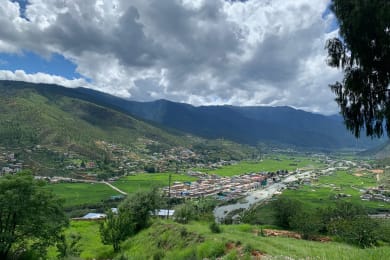
Day 2
Paro / Transfer to Haa valley (2700m) via Chele La Pass (3900m)
Today, after early breakfast, we will drive to Haa Valley via Chele La Pass. En route, visit Kila Gonpa Nunnery and see the oldest temples in the Haa valley. The total driving distance is 75km and takes about 2.5 hours. Kila Gonpa Nunnery: The nunnery is home to dozens of nuns. Located on a cliffside below Chela La Pass, today the nunnery is accessible by road. It is about 33km from Paro town. Before the road was extended until the nunnery, it was an hour hike from the nearest road head. You’ll have an opportunity to meet with peace-loving nuns and offer prayers at the monastery. From there we drive back to the main road and continue the journey. En route stop briefly at Chele La Pass. At 3900m above sea level, Chele La Pass is the highest motorable road point in Bhutan. On a clear day, the mountain pass offers a grand view of surrounding Himalayan peaks, Paro valley and Haa valley. We can spend some time walking along the pass among the colourful prayer flags and enjoying the beautiful views around and appreciate the pristine environment. If you are interested, we can arrange a prayer flag hoisting activity for a small fee. The prayer flags are traditionally hoisted to bring peace, harmony, ward off bad luck and clear obstacles on your path. From Chele La Pass, the drive to Haa Valley is a gradual downhill and will take less than an hour to reach Haa. On reaching Haa Valley, you’ll visit the two oldest temples in the valley, Lhakhang Karpo and Lhakhang Nagpo. Both the temples were built in the 7th century by the Tibetan King Songtsen Gampo in his mission to build 108 of such temples to subdue the spirit of giant ogress that was obstructing the propagation of Buddhism across the Himalayan region. Dinner and overnight at Soednam Zingkha Heritage Lodge or Risum Resort. Soednam Zingkha Heritage Lodge is a refurbished farmhouse equipped with a traditional hot stone bath believed to have a therapeutic and revitalizing effect.
Guide: Included for the day
Meals: Breakfast, Lunch, Dinner
Accommodation:
- 3-Star Accommodation: Soednam Zingkha Heritage Lodge
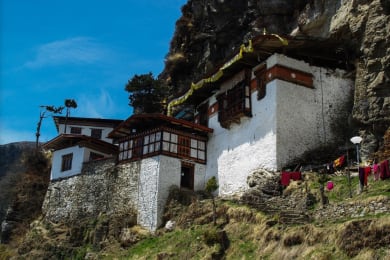
Day 3
Hike to Juneydrak / Transfer to Thimphu (2334m) via Dobji Dzong
After an early breakfast, drive to the village of Katsho and hike to Juneydrak Hermitage or drive to Katsho Gonpa. After lunch, transfer to Thimphu via 16th-century Dobji Dzong. The total driving distance is 110km and takes about 4.5 hours. Hike to Juneydrak: The uphill hike begins from Katsho village and takes about 1 hour through the pine forests and rhododendron trees with beautiful flowers blooming in spring from April to early June. The path closer to the hermitage is quite narrow through the rocky cliff but the hike is worthwhile. You’ll enjoy the top-down view of the Haa valley from the hermitage. At the hermitage, you’ll see a footprint left by Machig Lhabdron, the renowned 11th-century Tibetan Yogini. For those not interested in hiking, drive about 3km from the Katsho Village and visit Katsho Gonpa (monastery) overlooking the Haa valley. Several monks are studying at this monastery. Return to the lodge/hotel for lunch or packed lunch can be arranged which you can enjoy as a dry picnic on the way back from Juneydrak. After lunch, transfer to the capital city Thimphu via Dobji Dzong. The 16th-century Dobji Dzong (Dzong in Bhutanese means “fortress”) was built by Lama Ngawang Chogyal. Legend has it that Ngawang Chogyal has followed the spring originating below the throne of Jetsun Milarepa in Tibet. The source of the spring was found to be a rock located on the current location of Dobji Dzong, which was then chosen for its religious significance. Continue driving to the capital city Thimphu, home to approximately 115,000 residents. This bustling little city is the main center of commerce, religion and government in the country. On arrival in Thimphu, check into the hotel and rest of the evening at leisure. Dinner and overnight at Kuenphen Rabten Resort or Hotel Amodhara
Guide: Included for the day
Meals: Breakfast, Lunch, Dinner
Accommodation:
- 3-Star Accommodation: Kuenphen Rabten Resort
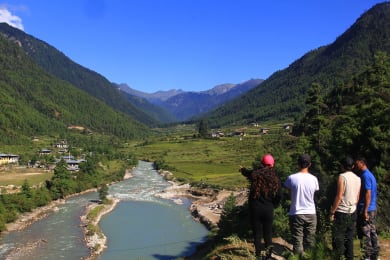
Day 4
Full day exploring Thimphu (2334m)
After breakfast at the hotel, we begin the day by first visiting the magnificent 169 feet tall bronze statue of Lord Buddha located on a hilltop overlooking the Thimphu valley. It was built to celebrate the 60th birth anniversary of the Fourth King His Majesty Jigme Singye Wangchuck and also to usher peace in the world. (OPTIONAL) From there, we do a 2-hour leisure hiking in the outskirts of the capital city from Kuensel Phodrang to the 13th-century Changangkha Lhakhang gives a grand overlooking view of Thimphu valley. The hiking trail leads through sparsely populated pine trees, offering families and nature lovers a perfect opportunity to spend their leisure time. At the end of the hike, visit the Changangkha Lhakhang by the 13th-century Tibetan Scholar Lama Phajo Drugom Zhigpo who played an important role in the early spread of the Drukpa school of Tibetan Buddhism in Bhutan and subsequently became the state religion. Changangkha temple is considered the national treasure. From there we drive to the northern outskirts of Thimphu to see the only animal enclosure in Bhutan, Royal Takin Preserve. Takin (Budorcas Taxicolor) is the national animal of Bhutan and they are usually found at an altitude ranging from 1,000 to 4,500 meters above sea level. After a traditional lunch at the Folk Heritage Museum, we visit the National Insitute for Zorig Chusum where the 13 traditional arts and crafts of Bhutan are taught. If interested, you can also visit the Centenary Farmers Market to get ingishts into the food preference and culture in Bhutanese society. Farmers from across the country bring their farm produce to sell at the market. We then pass by Changlimithang Archery Range to witness the game of archery if the match is in progress. You'll see archers dancing and singing each time they hit the target from a whopping distance of 145m. Archer is the national sport of Bhutan. Leisure time. Dinner and overnight at Kuenphen Rabten Resort of Hotel Amodhara
Guide: Included for the day
Meals: Breakfast, Lunch, Dinner
Accommodation:
- 3-Star Accommodation: Kuenphen Rabten Resort

Day 5
Thimphu / Transfer to Phobjikha valley in Gangtey (3000m)
After breakfast, transfer to Phobjikha valley in Gangtey. The total driving distance is 135km and takes about 4.5 hours. En route, we stop briefly at Dochula, a sacred mountain pass at an altitude of 3150m. You can see, on a clear day, some of the highest mountains of Bhutan. From Dochula, the drive will be downhill until we reach the village of Sopsokha where we stop to visit the famous Chimi Lhakhang popularly known as the "Temple of Fertility". Built in the 15th century, this temple is known for couples who are unable to have children as it brings fertility to them, giving them the ability to bear offspring. Because of this belief, people like to call Chimi Lhakhang the “Temple of Fertility”. Explore the nearby village where you'll find the houses painted with giant phalluses on either side of the main entrance to dispel curses and bad luck. After lunch, we continue our journey to Phobjikha valley. Phobjikha is a vast U-shaped glacial valley at an elevation of about 3,000m/9,840ft and it is a winter home for endangered Black Necked Crane from November to March and migrates back to Tibetan Plateau by the beginning of the spring season. As part of the conservation effort, Phobjikha valley has been declared a protected area. Arriving Phobjikha valley, visit Gangtey Monastery, the famous 17th-century landmark in Phobjikha valley popularly known as Gangtey Gonpa. Founded in 1613, this is one of the largest monasteries in Bhutan. The monastery also has a monastic college where hundreds of monks study Buddhist philosophy for 9 years. If you reach Phobjikha early, you can do the Gangtey Nature Trail. Otherwise, you will do it tomorrow morning. Dinner and overnight at Dewachen Hotel & Spa or Yue-Loki Guesthouse.
Guide: Included for the day
Meals: Breakfast, Lunch, Dinner
Accommodation:
- 3-Star Accommodation: Dewachen Hotel & Spa
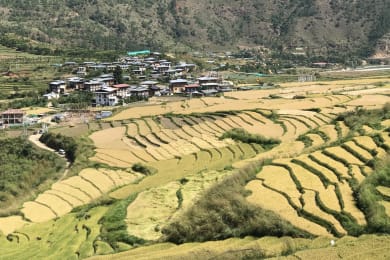
Day 6
Gangtey Nature Hike / Transfer to Punakha valley (1200m)
After breakfast, you'll go on an exhilarating Gangtey Nature Trail and after lunch, transfer to Punakha valley. The Gangtey Nature is about 5km and takes less than 3 hours through the valley giving you a great feeling of the valley and an understanding of the livelihood of the people living there. After lunch, transfer to Punakha valley. The total driving distance is 80km and takes about 3 hours. Arriving in Punakha, visit the architectural wonder of Bhutan, the 17th-century Punakha Dzong. The sacred wall paintings and main artifacts inside the dzong, the intricate woodworks and the architectural structure of the dzong exhibit a fine example of Bhutanese arts and craftsmanship which continues to influence Bhutanese architecture even today. From there, we walk to Bhutan's longest suspension bridge over the Phochu river. Punakha Dzong is built on a small stretch of land at the confluence of two glacial-fed rivers, Phochu (male) and Mochu (female). We then return to the road and drive to Namgay Zam Homestay in the village of Yusakha for overnight. Alternatively, if you enjoy walking, we cross the suspension bridge and continue to walk to Namgay Zam Homestay. The walk will take you through the beautiful terraced rice fields and should not take more than 30 mins. Staying at the village homestay is a perfect way to experience the life of an ordinary Bhutanese family. You can participate in preparing dinner and learn how to cook some of the popular dishes of Bhutan. If interested, you can also soak in a traditional hot stone bath believed to have a therapeutic and revitalizing effect. Dinner and overnight at Namgay Zam Homestay or Meri Puensum Resort.
Guide: Included for the day
Meals: Breakfast, Lunch, Dinner
Accommodation:
- 3-Star Accommodation: Namgay Zam home stay,Yusakha
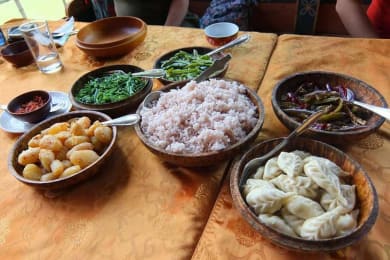
Day 7
Hike to Khamsum Yuelley Namgyel Chorten / Transfer back to Paro valley (2200m)
After breakfast, hike to the picturesque Khamsum Yuellay Namgyel Chorten located on a serene hilltop overlooking the fertile Punakha valley with glacial-fed Mochu river meandering through the valley. The hike leads through the terraced rice fields and a short climb just before reaching the chorten and the round trip hike takes about 2.5-hours for most visitors. After the hike, we return to the road head and drive to Punakha town for lunch. (OPTIONAL) White Water Rafting on Mochu River: If interested, you can go white water rafting on Mochu river graded 1-2 making it possible for all ages to try and experience rafting. The rafting distance on Mochu is 10kms and takes around 1.5 hours maximum. One raft which carries 6-8 passengers will cost around USD200 which is divided equally among the passengers. The best season for rafting is from March to June and September to November. After lunch, we drive back to Paro and stop briefly at Dochula Pass for a coffee/tea break. If you still have energy and love to walk in nature, a hike to Tashigang Gonpa is recommended. The hike to Tashigang Gonpa from Dochula Pass is a wonderful one taking you downhill through forests of Juniper, Hemlock, blue pine among many others. It offers a great opportunity to photograph nature and landscapes. You'll also come across different species of bird. The hike downhill takes about an hour. Tashigang Gonpa is a monastery located on top of a mountain below Dochula Pass. It was built in 1768 by the 12th Abbot of Bhutan, Je Kunga Jamtsho. The monastery houses priceless relics and several statues of past Abbots of Bhutan. Today, the monastery serves as a monastic school for dozens of monks. The hiking trail can get wet and muddy during the moon season of late June to early September. From the monastery, we drive to the main road and continue the journey to Paro. Dinner and overnight at Khangkhu Resort or Bhutan Mandala Resort.
Guide: Included for the day
Meals: Breakfast, Lunch, Dinner
Accommodation:
- 3-Star Accommodation: Khangkhu Resort
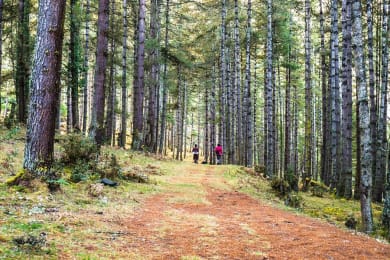
Day 8
Hike to the famous Taktsang Monastery
Today after an early breakfast, you will hike to the famous 17th-century Paro Taktsang Monastery popular known as the “Tiger’s Nest” and later in the evening visit a beautiful farmhouse for home-cooked local cuisines. Hike to Taktsang Monastery (Tiger’s Nest): Originally built in 1692, the iconic sacred site Taktsang is perched on the 800-meter rock cliff above the valley floor. The round trip hike takes about 4-5 Hours for most visitors. We recommend starting early before the sun gets stronger. One-way horse riding is available for about USD20 up to the midpoint (Taktsang Viewpoint Cafeteria). Horse riding on the way down is not recommended. The history of Taktsang is associated with the visit of Guru Padmasambhava (known as Guru Rinpoche), the Indian saint who came to Bhutan and introduced Tantric Buddhism in the 8th century AD. It is believed that Guru Padmasambhava flew into the cave from Kurtoe Khenpajong in eastern Bhutan, riding on a tigress. It is not only considered as one of the most sacred pilgrimage sites in Bhutan but also “a must-visit” place for tourists. After lunch at the Taktsang Viewpoint Cafeteria, we retrace our steps back to the base where the driver will be waiting. Later in the afternoon, visit a beautiful traditional farmhouse for an authentic dinner comprised of homecooked local cuisine. You can also soak and relax in a therapeutic traditional hot stone bath for an additional fee of about US$15 per person. Overnight at Khangkhu Resort or Bhutan Mandala Resort.
Guide: Included for the day
Meals: Breakfast, Lunch, Dinner
Accommodation:
- 3-Star Accommodation: Khangkhu Resort
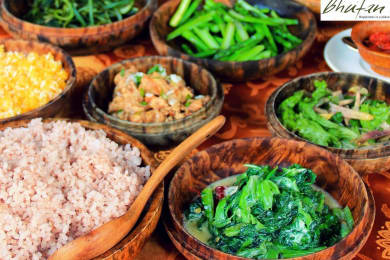
Day 9
Transfer to Paro International Airport for Departure
After breakfast, you will be transferred to Paro International Airport depending on your flight departure time.
Guide: Included for the day
Meals: Breakfast
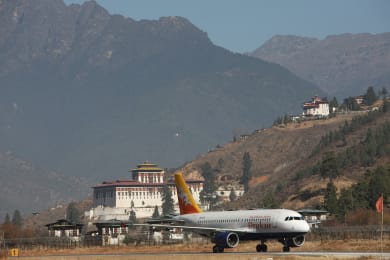
What’s Included
Accommodation
- Kuenphen Rabten Resort
- Namgay Zam home stay,Yusakha
- Khangkhu Resort
- Soednam Zingkha Heritage Lodge
- Dewachen Hotel & Spa
Meals
- Lunch (8)
- Dinner (8)
- Breakfast (8)
Transport
- All ground transports as per itinerary including roundtrip airport transfers are included.
- Luxury SUV for upto 2 pax
- Luxury SUV for upto 2 pax
- Luxury coaster bus for 9 pax & above
Activities
- Bhutanese traditional archery & dart throwing in addition to all activities as per itinerary.
Extras
- Visa Processing included. It takes only 3-4 working days. You'll receive your e-visa in PDF format.
- Entry fees to museum, national monuments & national parks are included
- English-speaking licensed private guide
- A set of national dress (Gho for men and Kira for women). The dress should be returned to the guide.
- Medical treatments at hospitals in Bhutan for any injuries sustained during the tour within Bhutan.
- Bottled mineral water in the car
- All internal taxes for services listed above
Not Included
- International Flights. Flights to and from Bhutan can be arranged with us.
- Therapeutic hot stone bath
- Tips to guide and driver
- Any other personal expenses
- Guide speaking other major languages can be arranged for an additional fee
About Karma Sangay
TEAM LEAD

+1 Local experts
Baboo Certified
5 (24 reviews)
I organize responsible and sustainable tours to Bhutan offering exclusive and guaranteed authentic experiences ensuring minimal impact on the environment and local communities while bringing economic benefit to the local people.
Travel that Makes a Difference
By choosing to travel with us, you support local communities, wildlife, and the environment. We are dedicated to positively impacting the world through every journey we offer.

Let’s regenerate the planet together
We overcompensate your entire journey’s carbon footprint including flights - for free.
$4,025.00 USD